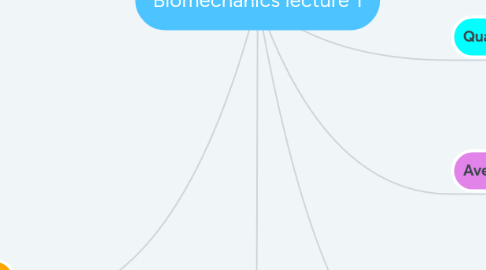
1. Kinematic descriptors
1.1. scalar
1.1.1. distance
1.1.2. has magnitude but no direction
1.1.3. speed
1.1.3.1. rate of motion without direction
1.1.3.2. distance / time
1.2. vector
1.2.1. velocity
1.2.1.1. rate of change of position but also includes magnitude and direction
1.2.1.2. displacement / time
1.2.2. displacement
1.2.3. acceleration
1.2.3.1. change in velocity / time
1.2.4. has magnitude and direction
2. Usain Bolt and Tyson Gaye race
2.1. broken into 4 segments
2.1.1. every 10m
2.1.1.1. looked at instantaneous velocity displacement / time interval
2.1.1.2. number of steps
2.1.1.3. stride rate
2.1.1.4. angel of shin and torso and and how these changed
3. Biomechanics lecture 2 - Angular Kinematics
3.1. Described motion
3.1.1. curvilinear
3.1.1.1. projectiles
3.1.1.2. not rotating around an axis
3.1.2. Angular
3.1.2.1. rotates around an axis
3.2. Projectile motion
3.2.1. the motion of any body both animate or inanimate that is in free fall that has been dropped or protected
3.2.1.1. human
3.2.1.2. animal
3.2.1.3. ball
3.2.2. forces
3.2.2.1. gravity
3.2.2.1.1. 9.807 m/s²
3.2.2.1.2. gravity is a uniform downward acceleration
3.2.2.2. air resistance
3.2.3. sports
3.2.3.1. prior to release
3.2.3.1.1. prior to release the flight pattern can be influenced
3.2.3.2. after release
3.2.3.2.1. it has a uniform downward acceleration due to gravity
3.2.4. kinematic equations
3.2.4.1. without time
3.2.4.1.1. Vf^2 = Vi^2 + 2*a*d
3.2.4.2. without distance
3.2.4.2.1. Vf = Vi + a*t
3.2.4.3. without final velocity
3.2.4.3.1. d = vi * t + (1/2) *a*t²
3.2.4.4. acceleration
3.2.4.4.1. a = 9.81m/s²
3.3. Projectile
3.3.1. 3 factors that influence
3.3.1.1. initial velocity (Vi)
3.3.1.2. angle of protection
3.3.1.2.1. Vx (the horizontal) is not influenced by gravity
3.3.1.2.2. Vy (the vertical) is influenced by gravity. Vy= Vi sinθ
3.3.1.3. height
3.4. Tangent
3.4.1. motion around an axis of rotation
3.4.2. tangent velocity = angular velocity * the radius
3.4.3. to increase tangential velocity, you must increase the radius. therefore increase the limb (racket, bat)
3.4.4. radius
3.4.4.1. the distance between the centre of the rotation and the motion
3.5. angular kinematics
4. Describing motion
4.1. linear motion
4.1.1. translation
4.1.1.1. all points in a line and have the same speed and direction
4.1.2. rectal linear
4.1.2.1. straight line
4.1.3. curvilinear
4.1.3.1. all points travel at the same angle and speed, but are not around an axis.
4.1.3.2. curved line
4.1.4. general
4.1.4.1. combination of rectal linear and curvilinear
5. Quantify motion
5.1. coordinate system
5.1.1. cartesian
6. Average speed
6.1. doesn't tell you
6.1.1. distance traveled
6.1.2. what happened during
6.1.3. what the top speed was
6.1.4. how long to get to the top speed
6.1.5. how long top speed was maintained for

